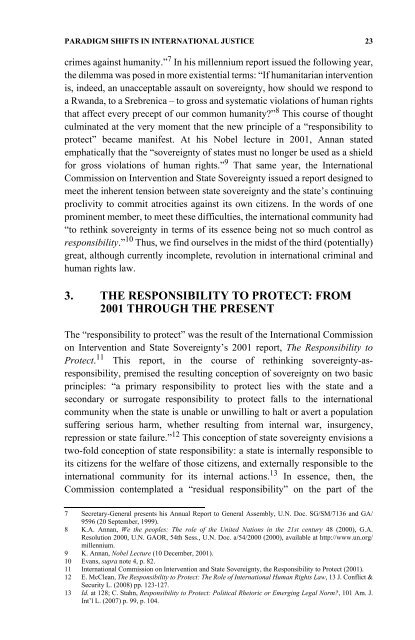University of Botswana Law Journal - PULP
University of Botswana Law Journal - PULP
University of Botswana Law Journal - PULP
Create successful ePaper yourself
Turn your PDF publications into a flip-book with our unique Google optimized e-Paper software.
PARADIGM SHIFTS IN INTERNATIONAL JUSTICE 23<br />
crimes against humanity.” 7 In his millennium report issued the following year,<br />
the dilemma was posed in more existential terms: “If humanitarian intervention<br />
is, indeed, an unacceptable assault on sovereignty, how should we respond to<br />
a Rwanda, to a Srebrenica – to gross and systematic violations <strong>of</strong> human rights<br />
that affect every precept <strong>of</strong> our common humanity?” 8 This course <strong>of</strong> thought<br />
culminated at the very moment that the new principle <strong>of</strong> a “responsibility to<br />
protect” became manifest. At his Nobel lecture in 2001, Annan stated<br />
emphatically that the “sovereignty <strong>of</strong> states must no longer be used as a shield<br />
for gross violations <strong>of</strong> human rights.” 9 That same year, the International<br />
Commission on Intervention and State Sovereignty issued a report designed to<br />
meet the inherent tension between state sovereignty and the state’s continuing<br />
proclivity to commit atrocities against its own citizens. In the words <strong>of</strong> one<br />
prominent member, to meet these difficulties, the international community had<br />
“to rethink sovereignty in terms <strong>of</strong> its essence being not so much control as<br />
responsibility.” 10 Thus, we find ourselves in the midst <strong>of</strong> the third (potentially)<br />
great, although currently incomplete, revolution in international criminal and<br />
human rights law.<br />
3. THE RESPONSIBILITY TO PROTECT: FROM<br />
2001 THROUGH THE PRESENT<br />
The “responsibility to protect” was the result <strong>of</strong> the International Commission<br />
on Intervention and State Sovereignty’s 2001 report, The Responsibility to<br />
Protect. 11 This report, in the course <strong>of</strong> rethinking sovereignty-asresponsibility,<br />
premised the resulting conception <strong>of</strong> sovereignty on two basic<br />
principles: “a primary responsibility to protect lies with the state and a<br />
secondary or surrogate responsibility to protect falls to the international<br />
community when the state is unable or unwilling to halt or avert a population<br />
suffering serious harm, whether resulting from internal war, insurgency,<br />
repression or state failure.” 12 This conception <strong>of</strong> state sovereignty envisions a<br />
two-fold conception <strong>of</strong> state responsibility: a state is internally responsible to<br />
its citizens for the welfare <strong>of</strong> those citizens, and externally responsible to the<br />
international community for its internal actions. 13 In essence, then, the<br />
Commission contemplated a “residual responsibility” on the part <strong>of</strong> the<br />
7 Secretary-General presents his Annual Report to General Assembly, U.N. Doc. SG/SM/7136 and GA/<br />
9596 (20 September, 1999).<br />
8 K.A. Annan, We the peoples: The role <strong>of</strong> the United Nations in the 21st century 48 (2000), G.A.<br />
Resolution 2000, U.N. GAOR, 54th Sess., U.N. Doc. a/54/2000 (2000), available at http://www.un.org/<br />
millennium.<br />
9 K. Annan, Nobel Lecture (10 December, 2001).<br />
10 Evans, supra note 4, p. 82.<br />
11 International Commission on Intervention and State Sovereignty, the Responsibility to Protect (2001).<br />
12 E. McClean, The Responsibility to Protect: The Role <strong>of</strong> International Human Rights <strong>Law</strong>, 13 J. Conflict &<br />
Security L. (2008) pp. 123-127.<br />
13 Id. at 128; C. Stahn, Responsibility to Protect: Political Rhetoric or Emerging Legal Norm?, 101 Am. J.<br />
Int’l L. (2007) p. 99, p. 104.
















